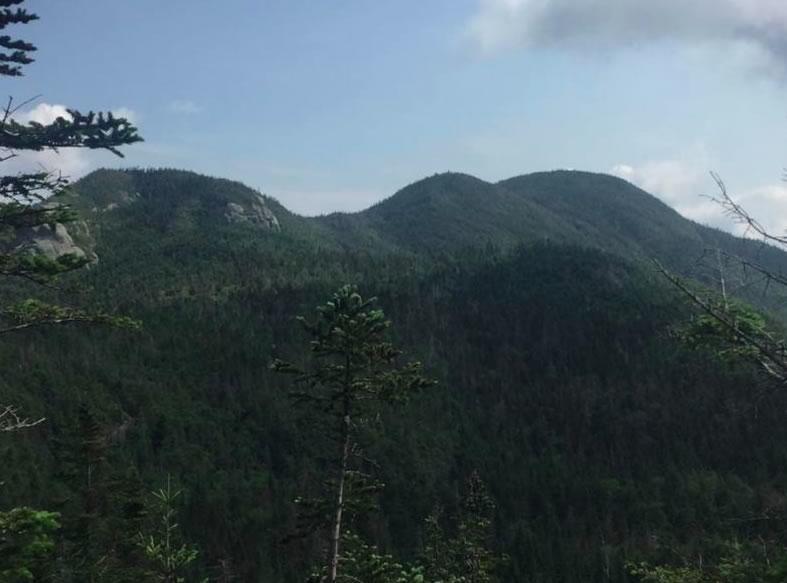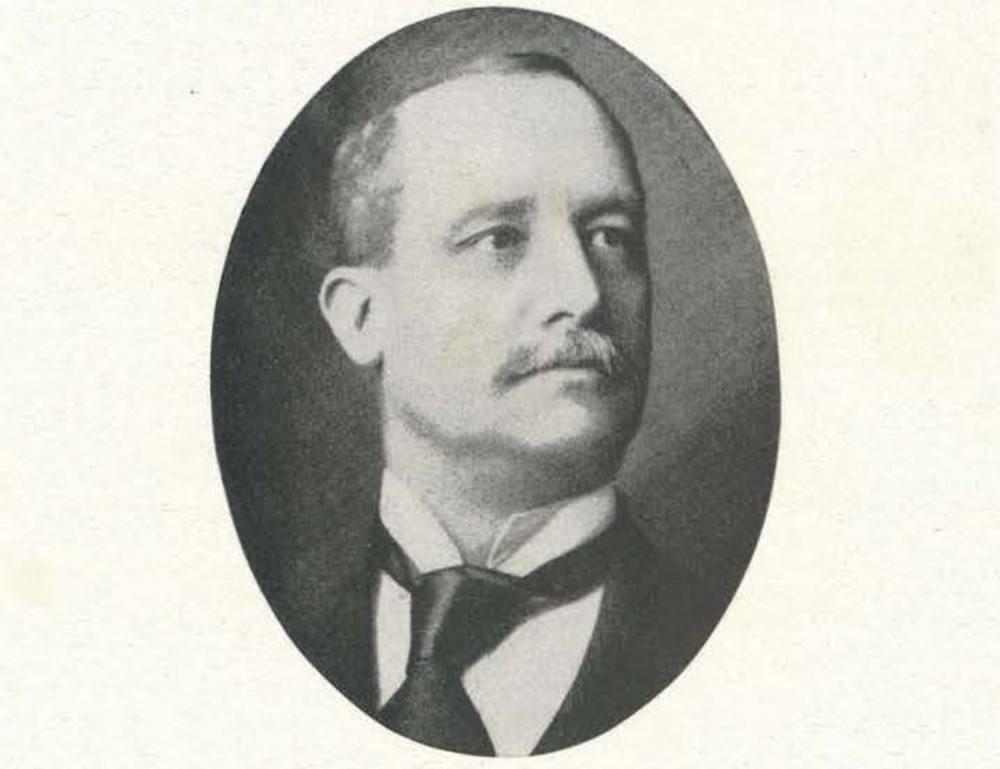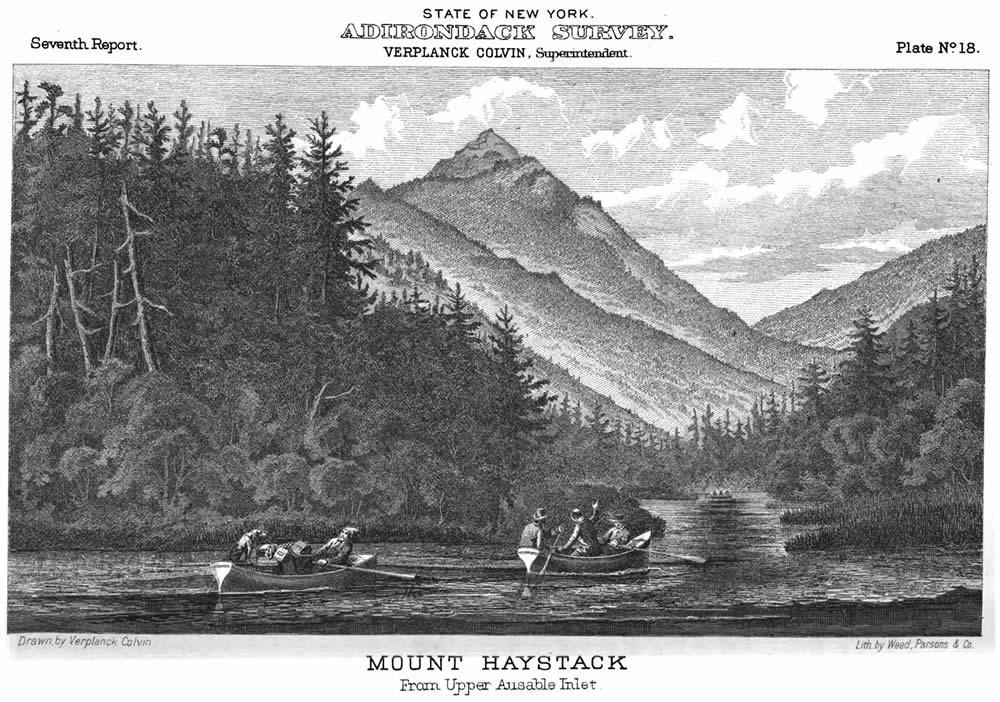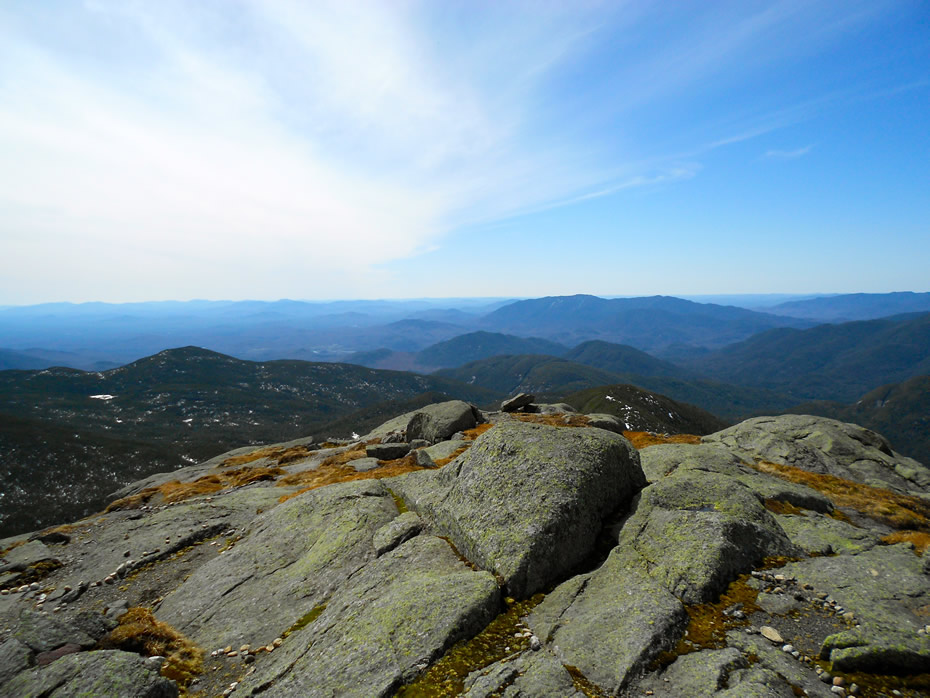Forever wild: The advocacy of Verplanck Colvin

A few dozen miles south of Tupper Lake is some of the most rugged and remote wilderness in New York State.
This is where Seward Mountain stands. Named after Secretary of State William H. Seward, it's the 24th tallest Adirondack High Peak at 4,347 feet in height. After walking for several miles through a flat, dense forest, climbers can expect a very steep and challenging hike up the mountain's exposed bedrock in order to reach the tree-covered summit. And in 1870 it was an Albany native who became the first person to record a successful ascent of this formidable peak.
Verplanck Colvin was a lawyer -- but he'd become known as the Great Surveyor of the Adirondacks and an advocate for the preservation of the six million acres that now make up the Adirondack Park.

Seward Mountain as viewed from Donaldson Mountain to the south.
Early Life and Career
Verplanck Colvin was born in Albany on January 4, 1847 to a wealthy family full of recognizable names from local history. His given name, "Verplanck," was the maiden name of his father's mother, Catherine Huyck Verplanck, who herself was the granddaughter of Barent Pieterse Coeymans, the namesake of Coeymans.
The family lived on Western Avenue in the Pine Hills neighborhood of Albany. There's a historical marker in front of the First Lutheran Church -- on the block between Quail and Cortland Place -- the marks the location of their home, "The Elms." He attended nearby Albany Academy, which was then located downtown near the Capitol.

Verplanck Colvin. / via NYSDEC
Colvin was a teenager when the Civil War broke out and his family moved from Albany to rural Nassau in Rensselaer County. It was there that he began to gain a deep appreciation for the wilderness of New York State as well as the science of topographical engineering, spending hours, if not days, at a time exploring the forests which surrounded his home. He honed his craft by preparing topographical maps of the country and immersed himself in outdoor life.
Rather than continue to pursue his new hobby, Colvin studied law under his father, James Colvin, who was a high-profile attorney (first elected district attorney in Albany County) and state Senator. He was relatively successful as an attorney.

Colvin's sketch of Mount Haystack, the third tallest mountain in New York State, from the Annual report on the progress of the topographical survey of the Adirondack region of New York (1879)
However, Colvin couldn't resist his true calling in life and soon began to devote himself to the science of topography as well as fully experiencing the then-relatively undocumented New York State wilderness.
One of the most recognizable geological features in the Capital region is the Helderberg Escarpment, a little over 10 miles west of Albany. In 1869, Colvin created a topographical and geological survey of the escarpment that was illustrated via sketches. An abstract of the escarpment was purchased by Harper's Magazine, a well-known national print publication even then, which brought welcomed exposure to Colvin's scientific work as well as increased his name recognition.
Colvin went across the country, sketching and mapping out the terrain as he visited the different regions of the United States. During the winter of 1870, he traveled the southern United States and then made his way west across the Great Plains towards Colorado to climb and map the highest mountains in the Rocky Mountain chain.
His time in Colorado prompted another feature in Harper's, an article titled "The dome of the continent," which earned him not only widespread praise for his successful ascent and depiction of some of the most challenging peaks in North America, but also got him elected an honorary member of the Rocky Mountain Club of Denver, a rarely-conferred honor.
The Great Surveyor of the Adirondacks
Having experienced for himself the vast natural beauty of the United States, Colvin traveled back to his home state of New York to do what he could in order to ensure the preservation of the state's wilderness for generations of New Yorkers to come. In a 1868 speech in Lake Pleasant, he affirmed for the first time publicly that he supported preservation of the region that would become the Adirondacks.

The summit of Mt. Marcy, the highest of the High Peaks. / photo: Casey Normile
Said Colvin of what would become the Adirondack State Park: "It is impossible for those who have not visited this region to realize the abundance, luxuriance and depth which these peaty mosses - the true source of our rivers - attain under the shade of those dark northern evergreen forests... The remedy for this is an Adirondack park or timber preserve."
Colvin's advocacy earned him an appointment to the Commission of the State Parks of New York in 1873. As part of the commission, Colvin conducted an in-depth topographical survey of the Adirondack State Park. And it was during that survey in 1875 that he conducted the first measurement of Mt. Marcy, the tallest mountain in New York State -- with just a level and rod. He confirmed the height of the mountain to be 5,344 feet using a method known as triangulation.

"Measurement of Whiteface Mountain with Spirit-Level and graduated Rod", drawn by Verplanck Colvin, published in the Seventh Report of the Adirondack Survey, 1881 / via Wikipedia)
Triangulation is the process of determining the location of a point by measuring angles to it from known points at either end of a fixed baseline, rather than measuring distances to the point directly. Climbing every single one of 46 Adirondack High Peaks over the course of his career -- which culminated in his appointment as Superintendent of New York State Parks -- Colvin used the triangulation method to determine the elevations of all these mountains. The accomplishment earned him the nickname the "Great Surveyor of the Adirondacks."
Forever Wild

Mount Colvin as viewed from the Ausable Dam
Colvin continued to be a leading voice in the environmental preservation movement of the late 1800s into the early 1900s until his death in 1920. Mount Colvin, located in the Adirondack High Peaks Region, is named in Colvin's honor. So, too, is Colvin Ave in Albany.
Most importantly, though, one of the lasting environmental impacts of Colvin's advocacy for a state forest preserve, and the eventual "Forever Wild clause" in the New York State constitution in 1894. The clause states:
"The lands of the state, now owned or hereafter acquired, constituting the forest preserve as now fixed by law, shall be forever kept as wild forest lands. They shall not be leased, sold or exchanged, or be taken by any corporation, public or private, nor shall the timber thereon be sold, removed or destroyed."
In other words, all the land that makes up the state forest preserve, which includes all of the Adirondacks and Catskills, will be kept "forever wild." Even today, any physical alterations to the lands that lie within the state forest preserve must be approved via a constitutional amendment subject to a statewide vote by New Yorkers.
Justin Devendorf is a resident of the Pine Hills neighborhood of Albany. He currently goes to Albany Law School and created the Photozofalbany Instagram page, where he shares the history and beauty of New York State's capital city and the surrounding region one post at a time.
Say Something!
We'd really like you to take part in the conversation here at All Over Albany. But we do have a few rules here. Don't worry, they're easy. The first: be kind. The second: treat everyone else with the same respect you'd like to see in return. Cool? Great, post away. Comments are moderated so it might take a little while for your comment to show up. Thanks for being patient.
Comments
As a resident of VerPlanck St in Albany, which is near Colvin Ave, I approve of this post.
... said Alex on Apr 26, 2018 at 9:20 AM | link
Justin, I thoroughly enjoy reading your column ! I especially like all the historical tidbits that are placed throughout your article! Your writing is always a pleasure to read!
... said Lisa D. on Apr 26, 2018 at 9:25 AM | link
"In other words, all the land that makes up the state forest preserve, which includes all of the Adirondacks and Catskills, will be kept "forever wild.""
Confusing wording; the geographic Adirondacks and Catskills include both public and private lands, both inside and outside of the parks. The forest preserve only applies to state-owned land within the park boundaries.
... said Ed on Apr 26, 2018 at 1:07 PM | link
Forgot to also say, great article!
... said Ed on Apr 26, 2018 at 2:28 PM | link
Colvin's maps are amazing and many have been digitized by the New York State Archives: http://digitalcollections.archives.nysed.gov/index.php/Detail/Collection/Show/collection_id/25.
... said Mike on Apr 28, 2018 at 12:52 PM | link
Colvin is buried in Grove Cemetery in Coeymans with other members of this family. The family also donated a receiving vault in the cemetery.
... said Rick Touchette on Apr 29, 2018 at 8:17 PM | link
Colvin did not climb all 46 High Peaks...
... said ADK TPR on May 2, 2018 at 11:45 AM | link